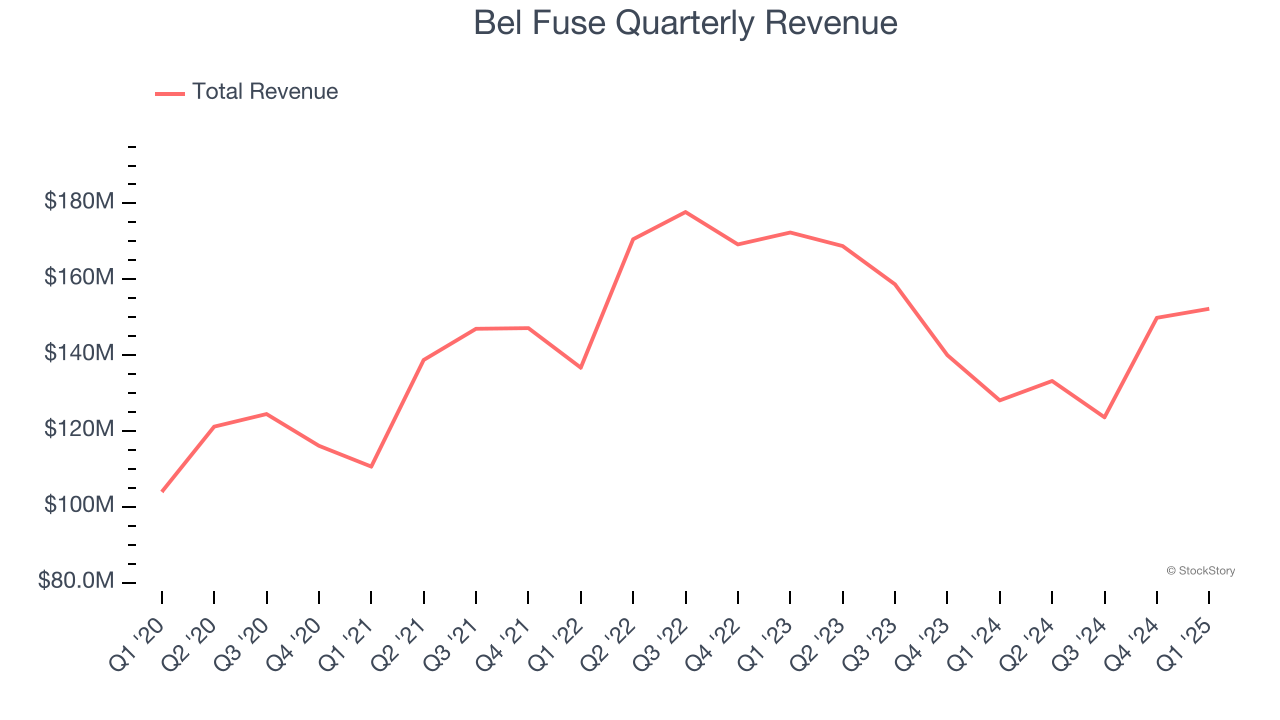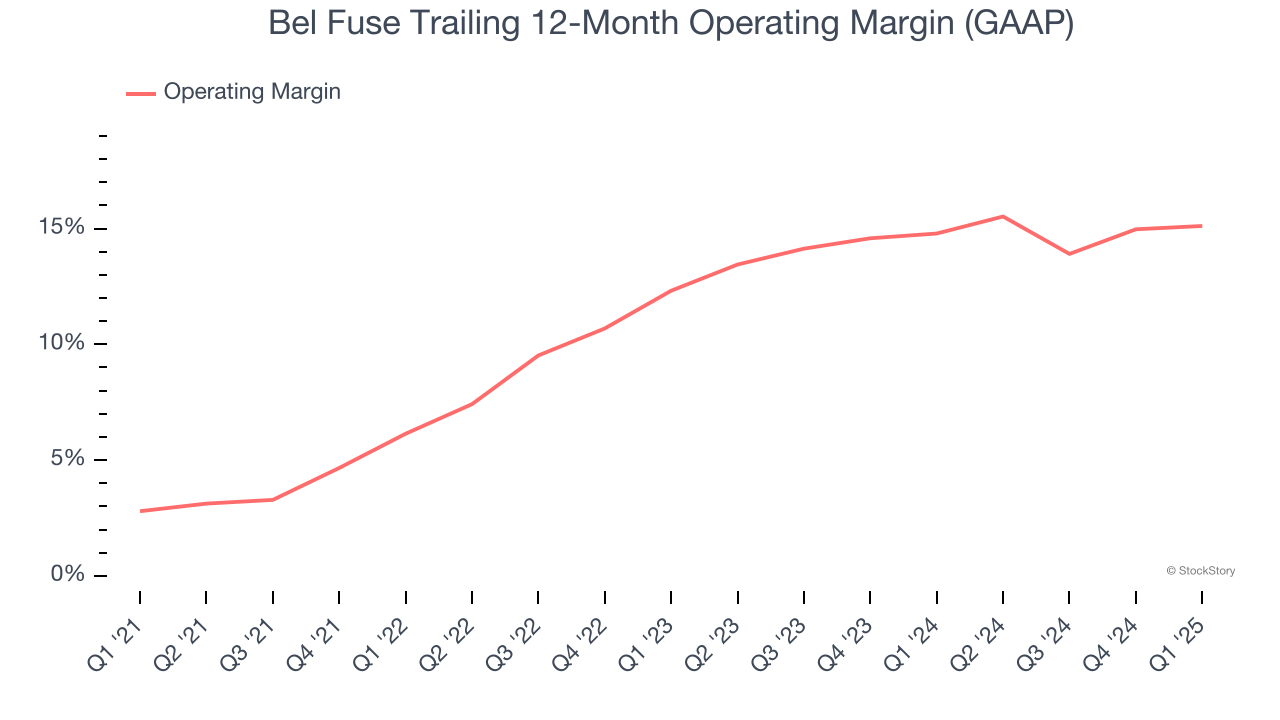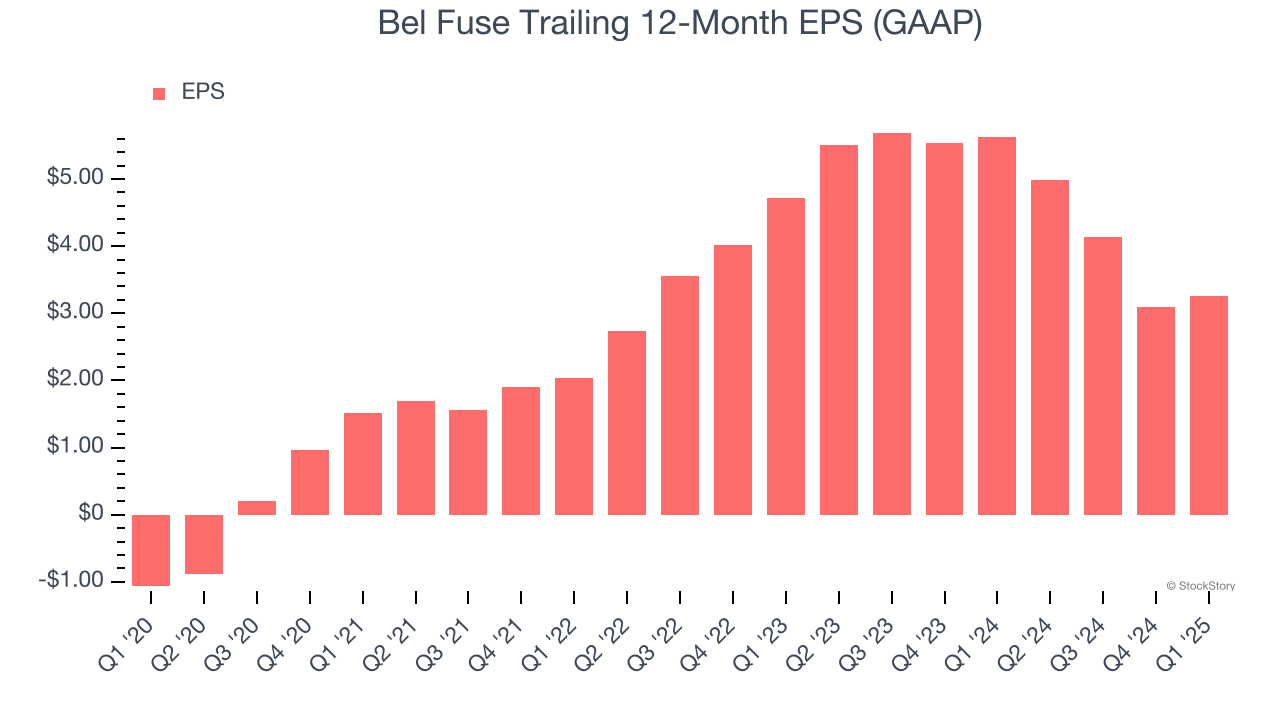
Electronic system and device provider Bel Fuse (NASDAQ:BELFA) reported revenue ahead of Wall Street’s expectations in Q1 CY2025, with sales up 18.9% year on year to $152.2 million. Its GAAP profit of $1.36 per share was 64.8% above analysts’ consensus estimates.
Is now the time to buy Bel Fuse? Find out by accessing our full research report, it’s free.
Bel Fuse (BELFA) Q1 CY2025 Highlights:
- Revenue: $152.2 million vs analyst estimates of $149.8 million (18.9% year-on-year growth, 1.6% beat)
- EPS (GAAP): $1.36 vs analyst estimates of $0.83 (64.8% beat)
- Adjusted EBITDA: $30.91 million vs analyst estimates of $24.39 million (20.3% margin, 26.7% beat)
- Operating Margin: 14.5%, in line with the same quarter last year
- Free Cash Flow Margin: 3.5%, up from 2.5% in the same quarter last year
- Market Capitalization: $880.8 million
“We are pleased with our first quarter results, which benefitted from our increased exposure within the defense and commercial aerospace industries and strength in the emerging AI end market,” said Daniel Bernstein, President and CEO.
Company Overview
Founded by 26-year-old Elliot Bernstein during the electronics boom after WW2, Bel Fuse (NASDAQ:BELF.A) provides electronic systems and devices to the telecommunications, networking, transportation, and industrial sectors.
Electronic Components
Like many equipment and component manufacturers, electronic components companies are buoyed by secular trends such as connectivity and industrial automation. More specific pockets of strong demand include data centers and telecommunications, which can benefit companies whose optical and transceiver offerings fit those markets. But like the broader industrials sector, these companies are also at the whim of economic cycles. Consumer spending, for example, can greatly impact these companies’ volumes.
Sales Growth
A company’s long-term sales performance is one signal of its overall quality. Any business can put up a good quarter or two, but the best consistently grow over the long haul. Regrettably, Bel Fuse’s sales grew at a sluggish 3.5% compounded annual growth rate over the last five years. This was below our standard for the industrials sector and is a poor baseline for our analysis.

We at StockStory place the most emphasis on long-term growth, but within industrials, a half-decade historical view may miss cycles, industry trends, or a company capitalizing on catalysts such as a new contract win or a successful product line. Bel Fuse’s performance shows it grew in the past but relinquished its gains over the last two years, as its revenue fell by 10% annually. 
This quarter, Bel Fuse reported year-on-year revenue growth of 18.9%, and its $152.2 million of revenue exceeded Wall Street’s estimates by 1.6%.
Looking ahead, sell-side analysts expect revenue to grow 17.2% over the next 12 months, an improvement versus the last two years. This projection is eye-popping and implies its newer products and services will fuel better top-line performance.
Today’s young investors won’t have read the timeless lessons in Gorilla Game: Picking Winners In High Technology because it was written more than 20 years ago when Microsoft and Apple were first establishing their supremacy. But if we apply the same principles, then enterprise software stocks leveraging their own generative AI capabilities may well be the Gorillas of the future. So, in that spirit, we are excited to present our Special Free Report on a profitable, fast-growing enterprise software stock that is already riding the automation wave and looking to catch the generative AI next.
Operating Margin
Operating margin is one of the best measures of profitability because it tells us how much money a company takes home after procuring and manufacturing its products, marketing and selling those products, and most importantly, keeping them relevant through research and development.
Bel Fuse has managed its cost base well over the last five years. It demonstrated solid profitability for an industrials business, producing an average operating margin of 10.6%.
Looking at the trend in its profitability, Bel Fuse’s operating margin rose by 12.3 percentage points over the last five years, as its sales growth gave it operating leverage.

In Q1, Bel Fuse generated an operating profit margin of 14.5%, in line with the same quarter last year. This indicates the company’s cost structure has recently been stable.
Earnings Per Share
Revenue trends explain a company’s historical growth, but the long-term change in earnings per share (EPS) points to the profitability of that growth – for example, a company could inflate its sales through excessive spending on advertising and promotions.
Bel Fuse’s full-year EPS flipped from negative to positive over the last five years. This is encouraging and shows it’s at a critical moment in its life.

Like with revenue, we analyze EPS over a more recent period because it can provide insight into an emerging theme or development for the business.
Sadly for Bel Fuse, its EPS declined by more than its revenue over the last two years, dropping 16.9%. This tells us the company struggled to adjust to shrinking demand.
In Q1, Bel Fuse reported EPS at $1.36, up from $1.19 in the same quarter last year. This print easily cleared analysts’ estimates, and shareholders should be content with the results. We also like to analyze expected EPS growth based on Wall Street analysts’ consensus projections, but there is insufficient data.
Key Takeaways from Bel Fuse’s Q1 Results
We were impressed by how significantly Bel Fuse blew past analysts’ EPS expectations this quarter. We were also excited its EBITDA outperformed Wall Street’s estimates by a wide margin. Zooming out, we think this was a good quarter with some key areas of upside. The stock remained flat at $65.32 immediately after reporting.
Sure, Bel Fuse had a solid quarter, but if we look at the bigger picture, is this stock a buy? If you’re making that decision, you should consider the bigger picture of valuation, business qualities, as well as the latest earnings. We cover that in our actionable full research report which you can read here, it’s free.
